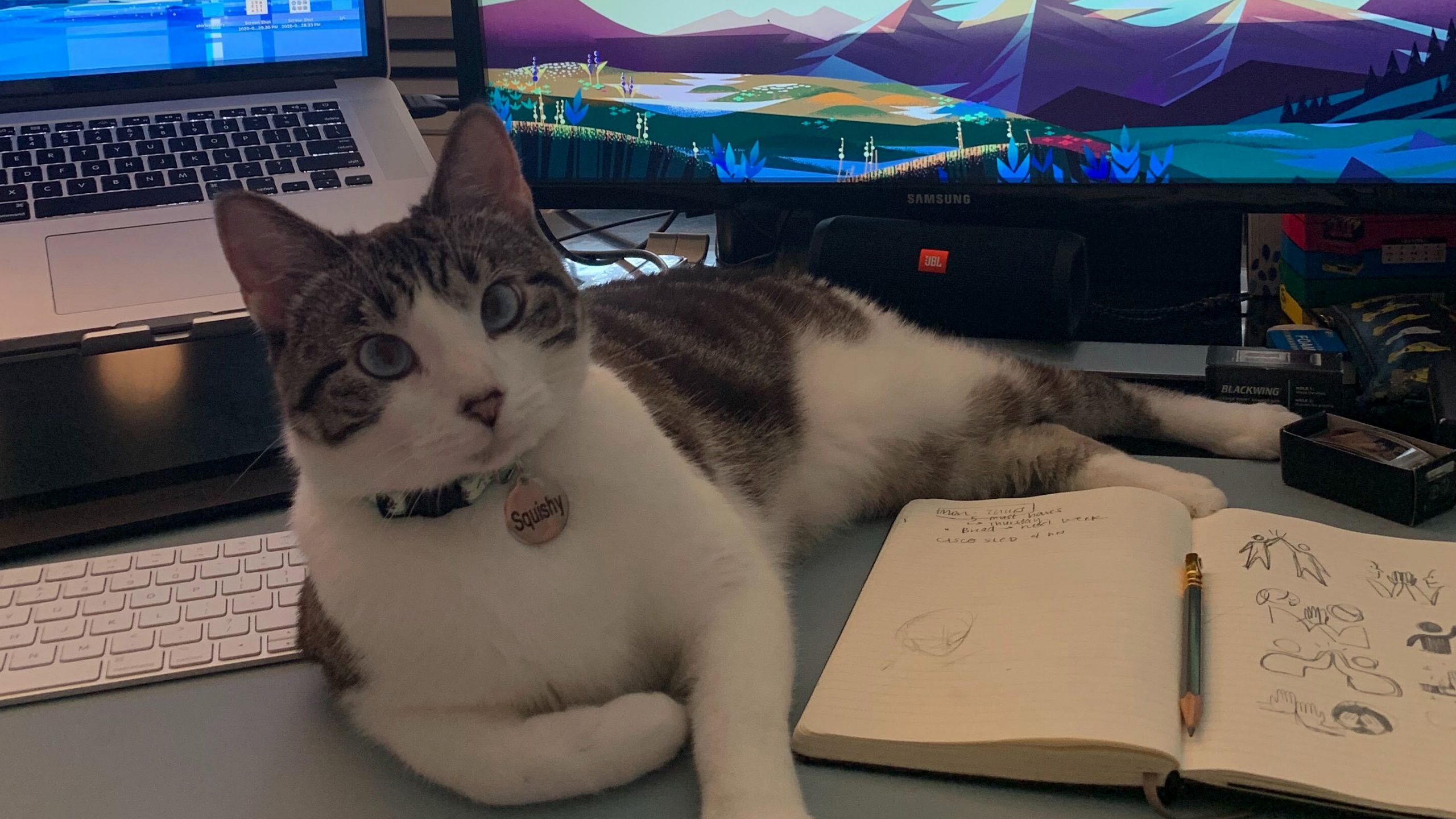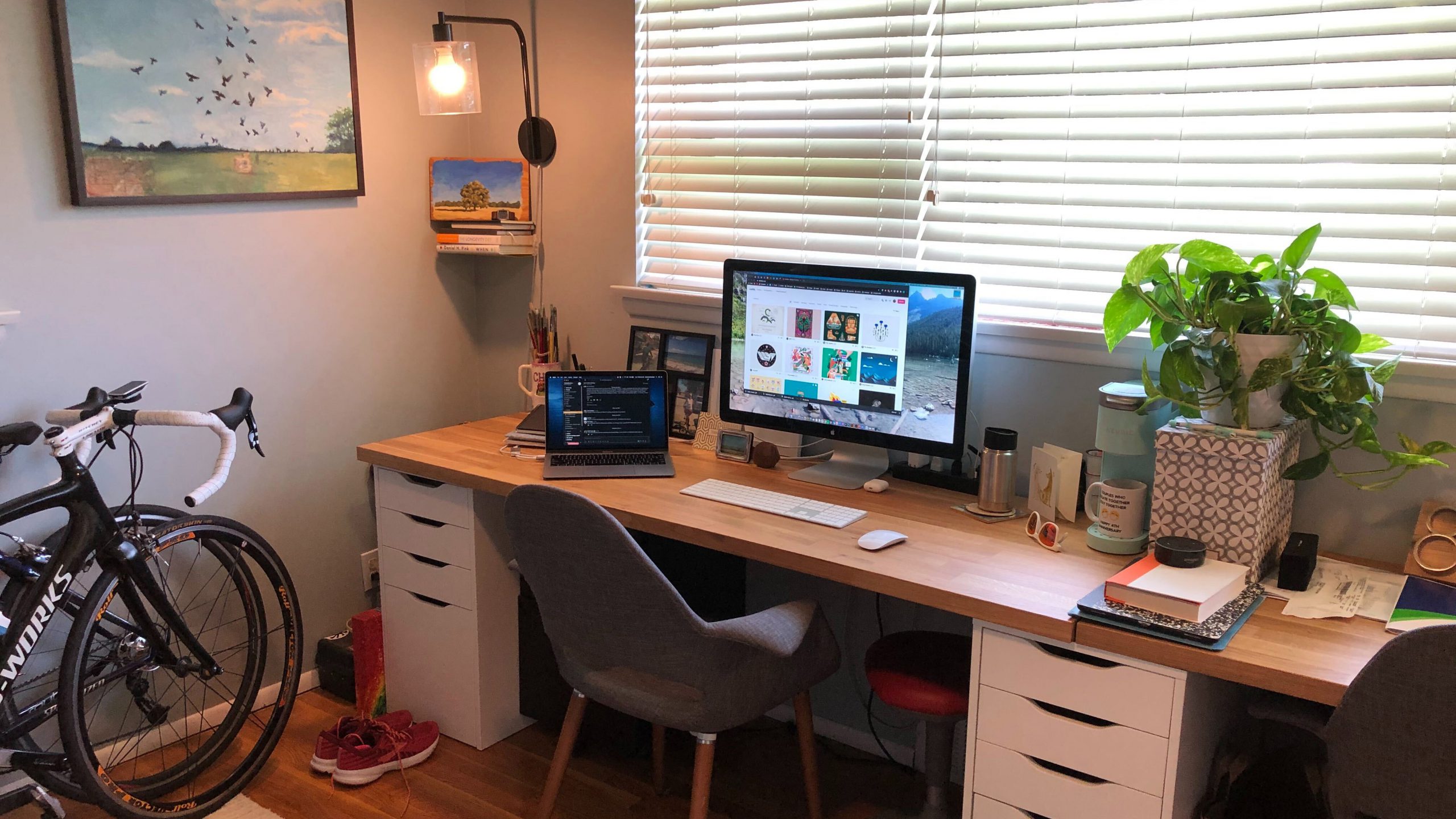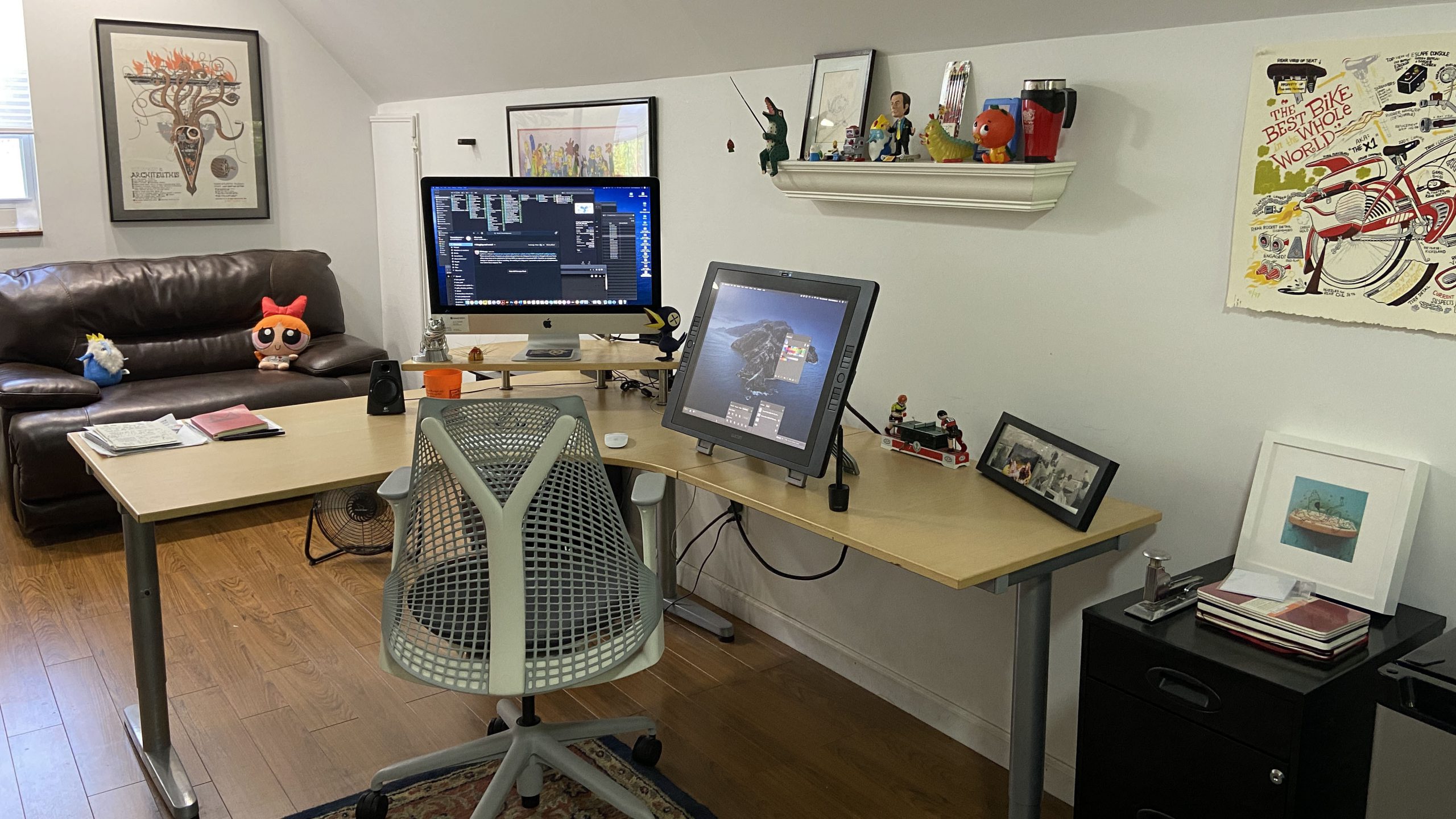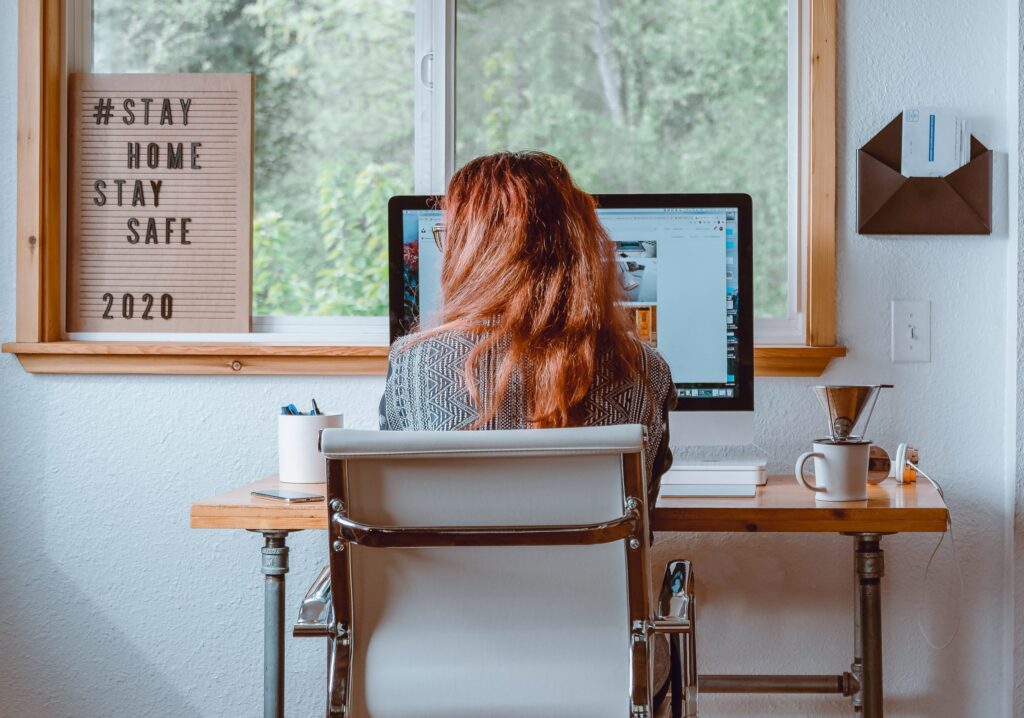Hack your home office
My father gave me a vintage drafting table when I graduated college and moved away to start the first real job of my career. The desk probably dates from the 1940s, is 6×3′, has four drawers, is made of wood, and is heavy.
Arguably, it’s overkill for the computer work I’ve been doing on it since everyone at Tremendousness started working from home two months ago. But I’ve used it for all kinds of creative work over the years—it’s scarred from X-Acto blades, stained from markers and paint, charred by irons, carved with kids’ names, and just generally worn from wear. The cigarette burns, however, were there when I got it.
Pre-quarantine, our policy was that everyone could work from home one day a week if they wanted or needed. So as a team we all had pretty regular experience with remote work—whether from home or while traveling or maybe just working away from your desk on one of the several couches in the office.
The reality of the daily WFH grind is quite different from that. No business’ office is perfect, but very few homes are designed or equipped for daily office work. Some of the problems can be solved by throwing money at them: a new desk, a better chair, a second monitor, stronger wifi, nicer headphones, etc. Of course flagrant spending is not an option for everyone.
But many of the challenges that come from working from home can’t easily be solved, even with money—especially when stay-at-home orders are involved.
If you’ve got young children, it’s gonna be hard.
If you’re a super-social person, you’ll get lonely.
If you’re easily distracted, there are endless… hmmm, maybe I should get that laundry in the wash.
Oops, sorry I got distracted.
If you don’t have much space, you’ll be uncomfortable and stir-crazy.
Kids need attention and nurturing, feeding and care. Family members may be out of work entirely, or struggling with multiple people all trying to work from the same home. And while it’s certainly possible in our line of work, not everyone thrives when work and home co-mingle to such an extent, and for such a long time. Those are bigger issues.
But here are some ideas. There’s no replacing the personal connections we had working in an office, but there are ways to make working from home a little better. The single most important thing is to somehow create a space—or at least a space within a space.
A few no-cost hacks
If your home office setup could use a little improving, here are eight ways to fix things up without spending anything.

Make space.
I’m lucky to have a finished attic for my office. It needs a pretty powerful window AC unit to cool off in the summer, but it provides me with space and privacy. Not everyone is so lucky. I feel like most people would do better to make up a dedicated space for working from home, even if it’s not a private room. We’re in this for a long haul so set up a workspace you can count on. That said, my wife works a few hours on the couch, a few at the dining table, and a few standing in the kitchen and gets along just fine. YMMV.
Put up signs.
Help yourself help others. Help others help you. If constant interruptions are causing problems, maybe a sign will help (not applicable to young children and rude family members or roommates). But instead of a simple “Do Not Disturb”, try something more like this multi-functional WFH sign: Mom’s Color-Coded Sign Shows Kids When She’s Available.
Hack together a whiteboard.
Sacrifice a framed piece of art. Well, not literally. If you’ve got a large framed poster or print (maybe at least 24×36″), pull it down and flip the art over so you’ve just got a white background under the glass or plastic. Hang it near you workspace. Ta-da, a makeshift whiteboard. The truth is a window could work too if it’s easily accessed.
Rig a standing desk.
Stack coffee table books. Use an upside-down laundry basket or milk crate. Heck, a cardboard box could work if you’re desperate. Many of us don’t have the nice chairs from our offices now, and regular kitchen table chairs aren’t so great for a full day of sitting. So find a way to work standing up for an hour here and there.
Move around.
Switch spaces throughout the day if you can. Take care of all your emails on the couch rather than at your desk. Sit in the kitchen or dining room for lunch. Go to the easy chair for a conference call. Crank on a project on the balcony or the patio, in the backyard… or even in the bath. I know that many people recommend a clear and hard separation of workspace from living space, but I also know that many people could benefit from an occasional change of both scenery and seating.
Take breaks.
You’ve heard this before, but you need to get up and move around from time to time; you need to reset every so often. Set a timer if you need to. Walk the dog. Play with the kids. Make tea. Do laundry. Sit in the sun. Move away from your desk and watch a silly 20 minute sitcom during lunch.
Do meal prep.
Maybe you like spending time preparing lunch. But if you don’t or simply need to be more efficient, you should try meal prepping. Maybe each week you eat the same lunch every day, then switch it up the following week. Maybe you just set aside dinner leftovers or have simple sandwich ingredients ready. Regardless, not having to figure out lunch every day is a time (and money) saver.
Rearrange.
If you simply can’t find a good place to set up your WFH station, maybe you need to rearrange. Personally, I love rearranging but many people find it tedious or disturbing. It might be as simple as replacing a small decorative table with a working desk, and it may be as big as putting every bit of furniture in a different spot so you can create room for a workstation. At least try it—you can always move stuff back if it doesn’t work.
Some inexpensive products
If you are able to spend only a little money, these little items might be a big help.

Door desk, ~$75.
Need surface space on the cheap? Sick of having to clear off the dining table every day? A basic hollow door from the hardware store and a couple budget saw horses, cinder blocks, or file cabinets make for a decent—and quite large—desk. We used these at XPLANE in the early days.
Adjustable portable desk, ~$40.
While it can be tricky to adjust these, they do work. Very helpful for raising your laptop to standing height on your desk or counter, as well as allowing it to breath when sitting on the couch (or in bed).
Lap desk, ~$20.
You may prefer a dedicated lap desk to help keep your laptop (and lap) cool. It gets the machine off your legs and onto a surface where it can breath. Blocking the fan vent is one of the main reasons your laptop runs loud.
Bath desk, ~$35.
Hey, why not? As long as you don’t have any video calls scheduled you might enjoy working in the bath now and then. (But if you are prone to clumsiness this may be a bad idea.)
Laptop stand, ~$40
Along with an external keyboard and mouse or trackpad, a stand like this creates a better ergonomic desktop setup for laptop users. It raises the screen closer to eye level and helps with cord management and cooling.
A desk plant, ~$20+
This is an easy way to beautify your little space.
A selection of “luxury” items
Finally, if you want to shell out the big bucks, these products make for nice upgrades.

Learniture Adjustable-Height Active Learning Stool, ~$100.
I quickly realized the vintage stool that came with the desk wouldn’t cut it for doing a full day’s work. My back started to hurt,. Sure, I wrote two books and designed countless projects in it over the years, but never in a full-time way. This is the stool I used in the office, so I brought it home.
Topo, the Not-Flat Standing Desk Anti-Fatigue Mat, ~$100.
“Topo is the anti-fatigue mat designed for standing desks. Its industry-leading contours and engineered material deliver a unique combination of micro and macro movements that erase the fatigue caused by stationary standing.”
An office chair upgrade, ~$300+.
Chairs are an extremely personal choice, so here’s a Wirecutter post on the best office chairs for 2020. Take your pick.
A 34″ wide, 21:9, curved ultrawide monitor, ~$400+.
Not everyone needs one of these, but they really do make your digital workspace much more expansive (and expensive). Keep all your important apps open and visible. Reference multiple documents at once. Watch a movie while you work… OK, forget that one. We’re mostly designers here at Tremendousness, so this might be more valuable to us than to others—but we think you’d love it.
Artifox desks, ~$1000+.
This St. Louis company makes great stuff. “ARTIFOX designs and manufactures beautiful minimalist products for home and office spaces. Made from high-quality materials, and packed for easy shipping and portability, each ARTIFOX product is perfect for the modern urban professional.”
Whether you go the cheap or expensive route, it’s probably time to hack your home office. But before you spend any money, think hard about your space and how it could both be rearranged and enhanced with things you already have on hand.
Here’s a peek at some of our home setups.
Good luck!
Main photo by Tina Witherspoon on Unsplash. All other photos are some of our Tremendousness home office setups.
